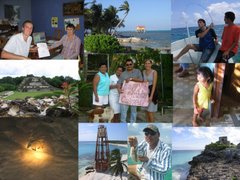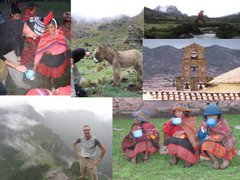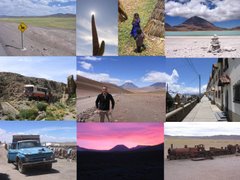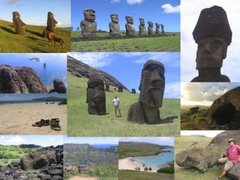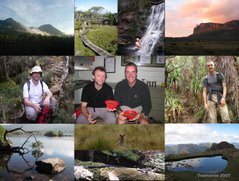What to say about the past week? There´s so much I could ramble on about: a 4 day trek through the Andes, altitude sickness at 16,000 feet, visiting extremely poor and remote villages in the mountains, Christmas Day (with mulled wine) in a tent, one of the greatest (and weirdest) train journeys in the world and an incredible day at Machu Picchu.
I don’t have much time to update the website before I have to leave for Bolivia, so once again, ill just let the pictures do the talking. Here´s a few photos from the first couple of days.
Cusco and AroundHadn´t done much travel planning beyond Belize - I thought Cusco was a small town, not a city of 500,000 people – doh. (Wearing my BCVI t-shirt in this pic!)
Cusco is truly built for taking photographs. The weather has been pretty mixed and it took me a while to adjust to the altitude of 3300m.
After a couple of days on my own in Cusco. I met up with the Dragoman group that I´ll be touring around Peru, Bolivia and Chile with for the next month. There are seven of us at the moment, though we´re losing a couple of people in the next few days.The first part of the tour was a four-day trek of the Lares Valley in the Andes. This was a little different to the typical Inca Trek as we were also visiting remote Andean farming communities with traditions dating back to the time of the Incas.Our first stop was in Quisharani, a village of a couple of hundred people at a height of 3,850 metres. We were dropped off by our bus with all our possessions for the next 3 days in the wilderness. After two days in Cusco I´d gotten over the tiredness, loss of apetite (no really!) and breathlessness at 3,300 metres, but this was higher still. A restless night under an incredibly clear, star-filled sky followed. But in the morning, the views were spectacular.

From Quisharani to Cuncan
The first night at altitude was bad. And we had barely started the trek the next morning when the effects of altitude on the body became clear. By the time we reached the peak for that day at 4,500 metres, one of our group of seven had spent most of the day on the emergency donkey and two of the others were struggling badly.
I had a pounding headache for a few hours, but the fantastic scenery was incentive enough to keep going. Only four of us survived to walk on the next day and I would have been more than disappointed not to be one of them.
Our second camp was at the village of Cuncan at 3,800m. As in the previous village we were welcomed by the locals, though neither we nor they seemed exactly clear on what our respective roles were. The intention of the alternative route is to give a more rewarding experience to the traveller by taking them away from the busy classic trail and giving them exposure to more remote and poorer local communities. Also, both through having the opportunity to sell souvenirs to travellers and through the fraction of the trip cost that goes towards the funding of education and other services, two of the poorest communities in the Andes can at least receive some benefit from the huge cash-cow that is tourism in the Peruvian Andes.A highly competitive game of football in Cuncan, the second village we visited.
In practise, I found that there wasnt a lot of interaction between ourselves and the commnities. We were warmly welcomed, and the locals were very friendly and keen to sell us local handicrafts. However, we didn’t really have any structured interaction with the locals beyond an impromptu football game and giving out hot chocolate and buns.
As it was Christmas, we gave out hot chocolate and buns to the locals. This was obviously a real treat for children and adults alike.
I would like to have seen more about how activities in the community worked , forexample the local school, which was being funded partly through the money we paid for the trip. Though the fact that the school had closed for Chistmas was a bit of an impediment.
Throughout our trip we were catered for by a group of five porters and two chefs. We also had our very experienced and knowledgable guide ‘Smithy’ - far left in this picture, next to Adrienne, Ali, Diana and Clint.From Cancun to the Sacred Valley
Activity in the communities ends shortly after nightfall, or in our case, a short while after dishing out the chocolate and buns. The next morning, our reduced group set out for the longest day – a nine hour hike up to 4,800m. The following photographs don’t quite capture how incredible the views were and how tough the climb was.
Christmas Day was also the final day of the trekand we had a beautiful four hour walk down into the Sacred Valley, from where we would catch the train to Machu Picchu the next morning.
Overall, though i thought the tour could be improved a bit, I was really impressed with the experience, and in particular with the work that Dragoman and Andina travel are doing in the villages. As I mentioned back in August, I intend to use some of the money I raised through sponsorship to help local causes that I see on my travels. I gave 200 US dollars to Andina travel as a donation to the villages of Quisharani and Cuncan. Thanks again for your donations and I will post details of how the money has been used. Ta.
Our camp on Christmas Eve was in an incredibly remote and beautiful location. What a place to wake up on Christmas morning.
Wednesday, December 27, 2006
Peru
Subscribe to:
Comments (Atom)






